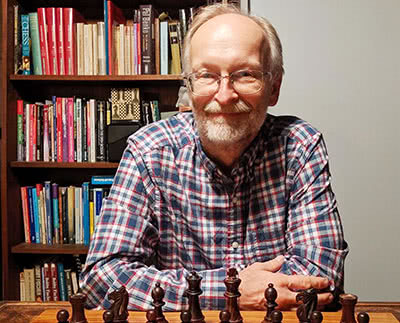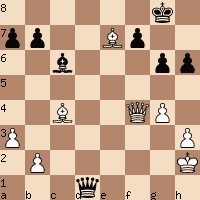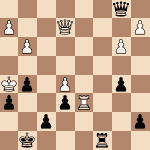Two traditions that were part of my formative years in chess now seem to be dying or dead. When I was an active tournament player (from around 1975 through 1996), post-mortems and newspaper chess columns were common. In this SparkChess article, published close to the Day of the Dead, I reminisce about post-mortems and my favorite newspaper chess columnist.
A post-mortem is conducted after a chess game ends. The participants in the game discuss their moves, sometimes in the presence of interested observers. Post-mortems may be less common than they used to be. With faster time controls, notation may not be required at all, or notation may end just when the game is getting interesting. That is, neither player has to record moves if one player has less than five minutes on the clock. Thus, opponents may not remember the entire game to review it. Furthermore, the next round may be coming up very soon, as fast time control tournaments usually cram in as many rounds as possible into one day. So the players may forgo post-mortems to rest or eat before the impending next round.
Computers have also affected post-mortems. If the “right” moves can be found by feeding the notation of one’s game into a computer, why bother to ask one’s opponent about his or her thoughts on that game?

International Master Jack Peters emailed me this paragraph about post-mortems “Many players enjoy discussing a game right after it finishes. I’m often surprised by my opponent’s comments. Sometimes an opponent will mention an idea that never occurred to me, or he will quickly dismiss a plan that I spent many minutes contemplating. No two minds think alike! One difference in today’s post-mortems is that all conclusions are tentative. We know that computer analysis will reveal new twists.”
One difference in today’s post-mortems is that all conclusions are tentative. We know that computer analysis will reveal new twists
When I lived in California, from 1987 to 1992, I bought the Los Angeles Times to read the chess column by Peters. The rest of the Sunday paper ended up lining my rabbit’s litterbox, but I still have several of Peters’ columns in my albums. In an article for the March 2011 issue of Chess Life, Peters wrote that his chess column for the L.A. Times had been terminated. Peters then gave a history of that column, which had just four different writers since becoming newspaper fixture in 1927. Peters was the last of those writers, with his column beginning in 1982 and ending in 2010. Newspaper journalists generally, and chess columnists in particular, have mostly been killed (metaphorically) by the Internet, at least here in the United States.
In England, Grandmaster Luke McShane is now the new chess columnist for The Spectator. In his inaugural column on October 5, he wrote, “It’s an honour to become The Spectator’s third chess columnist, after Raymond Keene and C.H.O’D. Alexander (who wrote under the pseudonym ‘Philidor’). I hope to prove as durable as my eminent predecessors.”
When I was researching post-mortems, I came across this interesting story from 1888. J. E. Tippett, known for writing a chess column for the San Francisco (California) Argonaut, wrote, “I am somewhat weary of what, in lieu of a better term, I call post-mortem victories.” He was disputing that Joseph D. Redding, another San Francisco resident who was a chess amateur, had achieved an even score against the recently-deceased Johannes Zukertort, challenger to Wilhelm Steinitz. Steinitz had become the first official World Chess Champion by defeating Zukertort by a score of 10 wins, 5 losses, and 5 draws in 1886. Tippett thought it unfair that Redding, after Zukertort died in June, seemed to be claiming to be Zukertort’s peer, which would be a post-mortem victory of sorts.
Newspaper columnist Tippett is of course now dead too, along with Redding and Zukertort. Fortunately, former newspaper columnist IM Jack Peters is still alive. He teaches a course titled “Chess and Critical Thinking” at the University of Southern California, and he plays several tournaments every year in California. When I asked Peters to recommend a game from the 1886 World Championship that had an exciting finish, he picked the seventh game of that match. See if you can solve the position after White’s move 34, where Black (Steinitz) has already sacrificed a bishop for a pawn. Thus, in the continuation you find, Black needs to either gain back that material or checkmate.


Problem solution – 1…, Qh1+ 2. Kg3, Qe1+ 3. Qf2 Qxf2# (Dove-tail Mate)